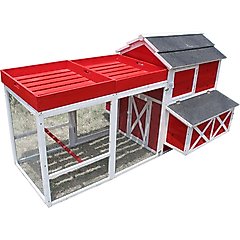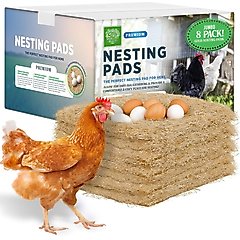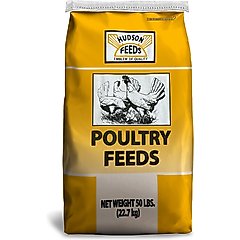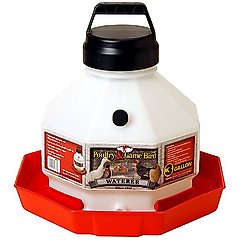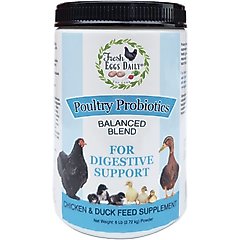Raising Chickens: How To Get Started
If having a flock of hens merrily clucking in your backyard sounds like a dream, you’re not alone. Raising chickens is a trend on the rise, as animal lovers realize the benefits of these cute, feathery companions who provide fresh eggs.
But as delightful as it all sounds, chicken rearing does come with responsibilities. From setting up your chickens with a sweet coop and run, to important daily upkeep, to learning about what chickens eat, we’re covering everything you need to know about how to raise backyard chickens. Welcome to Chicken Raising 101!
Can I Have Chickens in My Backyard?
You can raise chickens in a backyard that has enough space for your coop and pen, and so long as your city, state, and HOA allows chickens. Each chicken needs at least 3 square feet of space in their coop and an additional 10 square feet of space in their pen.
Chicken Ordinances
Before diving into the wonderful world of chicken keeping, check into your town’s ordinances. Chickens are becoming more accepted in cities, but there are often limits on the number of birds allowed, and a permit is typically needed for the chicken coop or the chickens themselves.
Lisa Steele, a fifth-generation chicken keeper in Maine and founder of Fresh Eggs Daily, notes that there are often regulations with selling fresh eggs too. If you’re raising chickens for eggs to sell, you’ll want to be aware of those requirements. When in doubt, check your local ordinances or contact an animal control officer for regulations regarding backyard poultry.
How Much Space Do Chickens Need?
You don’t need a huge space to keep chickens. Follow these basic guidelines:
- At least 3 square feet of chicken-coop space per adult chicken
- At least 10 square feet of pen space per adult chicken
That means a small flock of five or six chickens needs about a 4-by-6-foot coop, and an attached pen or run that’s roughly 6 by 10 feet, says Steele.
If you can give them more room to roam, even better, she adds—the more space they have, the happier they’ll be.
Creating a Safe Space for Chickens
You’ll want to make sure the backyard space is an ideal stomping ground for your friendly fowl. Consider these factors:
- Ideal chicken temperature: While chickens are hardy animals who can thrive almost anywhere, Steele says extreme heat can be hard on them. If you live in a high-heat area, keep chickens cool with shade, fans, and ice blocks. Also, make sure they have more than enough water.
- Predators: Foxes, weasels, hawks, eagles, “and even the neighbor’s dog” are potential predators for your chickens, Steele says. Fences around your yard can help and will prevent your chickens from running into the road as well. You’ll also want to make sure their coop and run is secured so predators cannot get inside, and that your backyard chickens are safely put to bed every evening. (More on that below.)
- Chemicals and toxins: Substances used to treat your yard, such as herbicides or pesticides, as well as swimming pool chemicals, can harm your flock. Keep your chickens away from any area of your yard that’s been treated with these substances, and make sure your chickens can’t access your neighbors’ gardens or yards, either.
Supplies Needed for Raising Chickens

Feeling confident in learning how to raise chickens once and for all? Here are all the supplies you’ll want to gather and keep on hand:
- Chicken coop
- Attached pen
- Chicken coop cleaners and accessories
- Bedding
- Chicken feed
- Rodent-proof containers to store the food
- Feeders and waterers
- First aid kit for injuries or minor illness
- Chicken treats
- Chicken supplements
Chicken Shelter (Coop)
Whether you build or buy one, the chicken coop will be your greatest expense. This is your chickens’ home, and it’s where they nest, lay eggs, and sleep.
In addition to the size (at least 3 square feet of space per chicken), you’ll want to ensure your coop is well-ventilated, and has enough roosting bar space for each bird to rest or sleep (around 8–10 inches of space per chicken).
For premade coops, expect to pay between $200 and $1,500 depending on size and quality. For a beginner coop, $300–$500 is a good investment.
Recommended Product
The coop needs nesting boxes too. These create a comfortable place for your chickens to sit and lay eggs. Plan for one box for every two to three hens. (Note: Premade coops often come equipped with nesting boxes.)
You’ll cover the floor of the coop and the nesting boxes with bedding. The bedding should be a nesting material such as pine shavings, corn cob, or hemp. These materials typically absorb your chickens’ mess more easily than other common bedding types like straw, making cleanup easier.
Recommended Products
Did You Know? Chickens take dust baths to keep their feathers clean and free of parasites like mites and lice. They instinctively dig shallow pits in dry, loose soil, fluffing the dust through their feathers to absorb excess oil and deter pests. Providing a designated dust bath area with sand, fine dirt, and wood ash helps maintain their hygiene and overall well-being.
Chicken Run (Pen)
An attached chicken pen is also necessary, especially if nobody is home during the day to keep your flock safe. It’s often called a run because it’s a space where your chickens can run around freely. There are two basic requirements for your pen:
- A large enough space (at least 10 square feet per chicken)
- Fully enclosed, with both a roof and walls of fencing or netting (to protect your chickens from predators—or from wandering off)
Many premade coops come with pens, but you’ll want to check that the run is big enough for the size of your flock. If necessary, buy or build an additional run to supplement the one that comes with your coop.
Chicken Feed
Chickens need fresh feed every day. Feeders made specifically for chickens are available, but trays, buckets, or sturdy containers can work too. Something simple, like Little Giant Hanging Metal Poultry Feeder, is perfect for food.
It’s also a good idea to invest in a sealed, rodent-proof container to store your chicken feed between feedings, to ensure freshness and protect it from pests.
As for what you should look for in feed for chickens, it’s important that your feed provides the protein and calcium your chickens need. Those needs will vary depending on the age and type of your chickens, so talk to your vet or a chicken expert at your local hatchery about the right feed for your unique birds.
If you have questions about your chickens’ diet, ask your veterinarian or a chicken expert at your local hatchery.
Recommended Products
Pro Tip: Chickens won’t overeat, so you can provide them with gallon or larger waterers, and gravity-style feeders that dispense feed as they eat it. This is often the best solution if you are away from home for several days—however, it’s best to check your chickens’ feed and water daily to ensure they have everything they need.
Water for Chickens
Along with replenishing your chickens’ food every day, make sure they have access to fresh, clean water to keep them healthy, happy, and productive. Steele says chickens need constant access to water, as dehydration can quickly lead to health issues and decreased egg production.
To keep the water free from contamination, dirt, and droppings, use an elevated waterer like this Little Giant Poultry Waterer. Note that in hot weather their water intake increases significantly, so it’s important to check and refill waterers frequently. During winter, ensure their water doesn’t freeze by using heated waterers or regularly breaking up ice.
Pro Tip: Keep electrolytes on hand in the summer months. “The heat can be difficult for chickens, so adding electrolytes to their water can sometimes be the difference between life and death,” Steele says. “In a pinch, you can also offer plain Pedialyte or honey water.”
Recommended Product
Chicken Supplements
You can also consider adding supplements to their diet, Steele says. These additions can support your chickens’ health and, if you’re raising chickens for eggs, it’ll affect their quality too. Here are a few common types:
- Calcium: Once they start laying, hens need a calcium supplement, even if they’re eating a good-quality layer feed. “The calcium supplement should be offered free-choice in a separate container, not mixed into the feed, so each hen can eat what she needs to lay eggs with strong shells,” Steele says.
- Grit: Since chickens don’t have teeth, they need to eat “chicken grit” to help crush up and digest their food. “You can buy commercial grit and again, offer that free-choice,” Steele says, “but if the chickens get some free-range time, they will pick up coarse dirt and small stones on their own to act as the grit.”
- Brewer’s yeast with garlic: This is a good overall addition to a flock’s diet, and crucial if you are raising ducks—because ducks need more vitamin B3 (niacin) than chickens do. Brewer’s yeast with garlic helps support immune and respiratory health as well as grow strong bones.
- Probiotics: Like humans, chickens can benefit from poultry probiotics in their diet to aid in digestive health. Steele explains that the probiotics support good bacteria in the gut to help fight bad bacteria the chickens might pick up.
- Flaxseed: “Hens can determine which nutrients to divert into the eggs they lay,” Steele says. “By adding flax to their diet, they will lay eggs with elevated omega-3 fatty acid levels, making for more nutritious eggs. The omega-3s also contribute to shiny, healthy feathers for the hen.”
- Sea kelp: Studies have been done using sea kelp as a natural antibiotic. “In addition, the kelp makes nice orange egg yolks, and provides beneficial vitamins and minerals,” Steele says. “Adding sea kelp to a flock’s diet gives them all the nutrients they need.”
Just like with their feed, your chickens’ supplement needs will vary depending on their age and type. Talk to your vet or chicken expert about supplements for your chickens.
Recommended Products
Steele adds that up to 10% of a chicken’s diet can be healthy treats, which can vary from garden or kitchen scraps to commercially produced poultry treats.
Chicken First Aid Kit
It’s a good idea to stock a first aid kit for injuries or minor illnesses your chickens may have. This kit should contain:
- Gauze
- Tweezers
- Gloves
- Vet wrap
- Saline flush
- Petroleum gel
- Contact info for a vet who treats chickens (in case of emergency)
What constitutes a chicken emergency? Any changes in your birds’ food or water consumption; lethargy or low energy levels; diarrhea or other stool changes; and upper respiratory symptoms like congestion are all reasons to call your vet. Plan to have a quarantine area for sick or injured chickens to keep them safe and isolated from the rest of the flock.
Chicken Breeds and Sourcing Chickens
Chickens are flock birds, so they prefer to be in a group. Get no fewer than three chickens, and if you have the space, five or six is an ideal flock size for a beginner chicken parent, Steele says.
Buying Chicks vs. Chickens
Most backyard chicken hobbyists keep female chickens (hens) since they’re the ones who produce eggs. You can get your chickens from a hatchery or farm supply store.
Many beginners buy chicks, aka baby chickens; others buy “teenage” chickens called pullets, who are typically 6–8 months old.
There are benefits and drawbacks to each:
| Benefits | Drawbacks | |
|---|---|---|
| Chicks | Chickens imprint, or form a strong attachment, to humans when they’re chicks, which can make them easier to manage throughout their lives. Plus, they’re super cute! | Brooding chicks (first two weeks of life) is more labor intensive at first, because they need a smaller enclosure and supplemental heat. Also, most breeds of chickens don’t produce eggs until they are 6–8 months old, so if you opt for chicks, you’ll have to wait. |
| Pullets | You’ll start getting eggs almost immediately! | Your chickens may be less attached to you; they’re still cute, but they’re not tiny, soft baby chick–cute. |
Which Chicken Breeds Are Best?
Generally speaking, all breeds are equally easy to raise. However, each has their own quirks and temperaments, so consider what you’re looking for and do some research in advance.
For example, maybe you’re looking for chickens with calm temperaments who do well with kids, or maybe you’re in the market for a high egg-producing chick, or want to have a chicken who lays colorful eggs. (Steele recommends the Meyer Hatchery site for breed information.)
“Pretty much any breed is going to do well in temperate climates, but if you live in the Southern States, then choosing breeds that handle the heat a bit better is a good idea,” Steele adds. “The smaller, lighter breeds with large combs usually do better in the heat, such as Andalusian, Leghorn, Penedesenca, or White-Faced Black Spanish.”
Also note that different breeds can live together, and it makes a more interesting flock and egg basket to mix breeds! This makes it easier to tell your chickens apart, as well, in case one is injured or sick and you are keeping an eye on it.
Pro Tip: If you add other chickens to your existing flock at a later date, quarantine the new additions in a separate area for at least 10 days and obtain any new chickens from a reputable source—one who keeps a vaccinated flock with no signs of disease. This can reduce the risk of introducing new pathogens and keep pecking-order dramas to a minimum.
Tips for Raising Backyard Chickens
If you’ve made it this far, that’s an excellent sign that you’re going to be an amazing backyard chicken parent. To recap some of what we discussed above and to give you an even clearer idea of how to raise chickens, read through this step-by-step guide.
1. Find the Perfect Place for Your Coop and Pen

Once you’ve assessed your backyard space to ensure it’s fit for chickens, find the perfect place for the coop and pen. Remember, a small flock of five or six chickens will need about 10 by 16 total feet of space. However, if you have room for a larger pen, that’s even better!
The pen should be completely enclosed to keep your chickens in and predators out. If your chickens are ever allowed outside of the pen (only under supervision), make sure water sources like ponds or pools are fenced in. The backyard itself should also be fenced to keep your chickens from roaming into a neighbor’s yard or the road.
2. Tend to Your Flock Daily

Every morning, you’ll need to let your flock out of their coop and into their pen so they can exercise and move throughout the day. You’ll also want to give them fresh water and food, collect their eggs, and do a light inspection of your chickens to make sure they’re looking happy and healthy. (More on that below.)
In the afternoon or evening, you can give them a snack before placing them back in their coop around dusk.
3. Clean the Coop and Pen Weekly
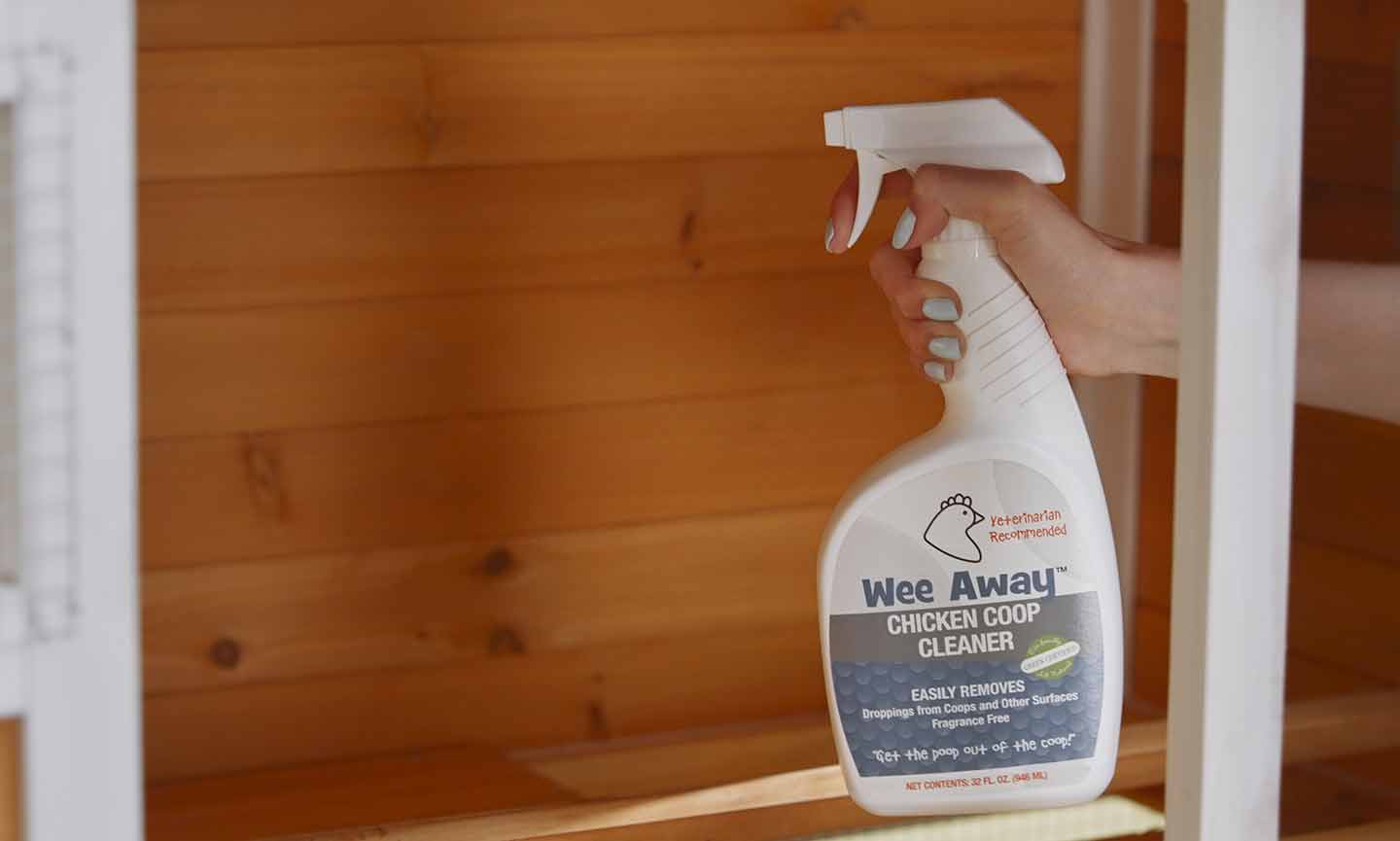
Along with your daily maintenance, you’ll want to allocate an hour or two every week to refresh your chicken’s bedding, and scrub their feeder and waterer. Natural cleaning products such as vinegar can be helpful in high traffic and other really dirty areas. Be sure to remove any debris before applying cleaner—it won’t be effective on organic materials like dirt, debris, or poop.
Adding a level of biosecurity for your flock is the most supportive measure you can take to limit any infections/transmissible disease. These measures help keep your babies safer and limit concerns with egg consumption.
- Having a pair of “chicken” shoes or dirty shoes that stay in the flock
- Wellness care from your vet
- Not sharing equipment with other “flocks” or farms
- Good pest control and mosquito control
TMI Alert: Chickens will poop just about anywhere they can roam, so if you’re hoping to keep your yard pristine, you’ll have to get used to a lot of cleanup duty—or else these might not be the pets for you.
4. Look Out for Potential Health Issues

Just like any other animal, birds are susceptible to falling ill. You’ll want to check your backyard chickens for signs of illness daily. These can include:
- Lethargy
- Lying down
- Fluffed feathers
- Not wanting to eat (even treats) or drink water
- Standing with eyes closed or head down
- Birds huddled together (flock illness)
- Runny droppings
- Bleeding
- Limping
- Black spots on their combs or wattles
- Runny eyes or nostrils
- Missing feathers
- Black spots on the bottom of the feet
The more time you spend with your chickens, the more you’ll get to know their typical energy levels and personalities—and the more likely you’ll be to notice signs of illness and injury.
Vaccines for chicks and chickens can help limit diseases—but not all potential health risks. Providing them with a clean environment, as well as plenty of exercise and sunshine, further reduces risk of illness and sets up your flock for a happy, long life.
Additionally, implementing biosecurity measures and knowing your babies well (noticing even subtle changes) to identify possible illnesses early is key to keeping them healthy. Steele also notes that routine vet visits you’d do for a cat or dog aren’t necessary for most flocks.
Establishing communication with a local veterinarian or state extension service is a great approach to ensure you have support with your chicks should any issues arise. However, it’s good to have a first aid kit on hand with basics like gauze; vet wrap such as Andover Healthcare PetFlex to hold the gauze in place; tweezers; and the contact information for a nearby vet who treats chickens, in case they fall ill.
FAQ About Raising Chickens
How many chickens do I need?
Starting with five or six chickens is ideal, because these animals are flock-oriented. That means they like to be around each other. The Farmers’ Almanac recommends starting with no fewer than three, but for these social birds, the bigger the party, the better.
What is the time commitment for raising chickens?
You’ll spend 10–20 minutes per day tending to them, and then about an hour or two on the weekends. In the morning you’ll let them into their run; replenish food and water; do a quick coop inspection; and collect fresh eggs. In the afternoon you can give them a snack, and in the evening you can put them back into their coop. Weekends are great for refreshing bedding, and scrubbing food and water feeders.
Are chickens hard to take care of?
Backyard chickens are not considered high-maintenance pets. Pet parents typically spend 10–20 minutes per day tending to their chickens, plus an extra hour or two every week for cleaning.
How many eggs do chickens lay?
Most hens lay one egg per day, but that rate can vary depending on anything from their diet to the weather.
What do you need in a chicken coop?
Chicken coops need to be big enough for the flock, with at least 3 square feet per chicken. They also need nesting boxes, a roosting bar, and good ventilation.
Do I need a rooster?
For backyard chickens who provide fresh eggs, you do not need to get a rooster. Roosters will fertilize the eggs your hens lay, which means you’ll be getting new chickens instead of edible eggs. Roosters also crow loudly, and there are more stringent ordinances and regulations in place for keeping them.
Congrats—you’ve just graduated from Chicken Raising 101! Raising backyard chickens can be extremely rewarding and fulfilling. We hope our guide has helped you feel confident in venturing into the world of chicken rearing, and that you have many delicious eggs in your future.
Attributions
This content was medically reviewed by Molly Price, DVM, Chewy veterinarian.
